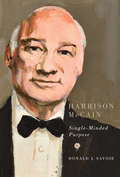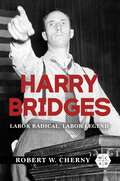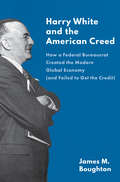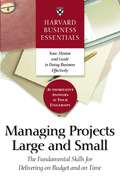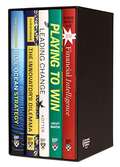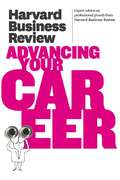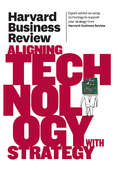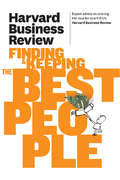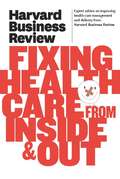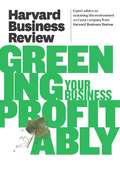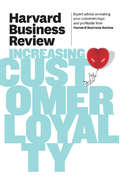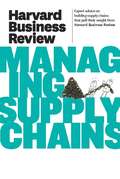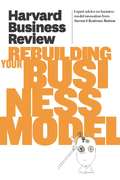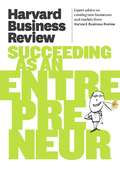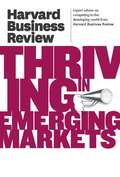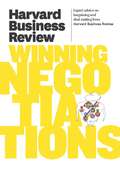- Table View
- List View
Harrison McCain
by Donald J. SavoieThe only rival to Harrison McCain's entrepreneurial success was his deep attachment to his Maritime roots. From McCain's beginnings in Florenceville, New Brunswick, the early mentorship he received from K.C. Irving, to the global success of his corporate empire McCain Foods, Donald Savoie presents a compelling and candid biography of one of the most famous and down-to-earth figures in Canadian business history. Savoie, a longtime friend to McCain, describes a driven, charismatic, and energetic man who had a keen wit and a deep commitment to his business and hometown. Through unprecedented access to McCain's papers and interviews with family members, friends, and colleagues, Savoie details the decisions that McCain made alongside his brother and business partner, Wallace McCain, from the company's humble beginnings to its expansion in Europe, Australia, India, and China. McCain saw the potential of globalization before others did. Despite conflict between the brothers and the eventual fracture of their partnership, Savoie presents the McCains' dedication as so immersed in the development of their company that they had little time left for second-guessing. At a time when New Brunswick struggles to reinvent itself economically, Savoie points to former government policies and programs that helped the company thrive and holds up the example of Harrison McCain with the hope of seeing Canadian success stories like this in the future.
Harrison McCain: Single-Minded Purpose (Footprints Series #17)
by Donald J. SavoieThe only rival to Harrison McCain’s entrepreneurial success was his deep attachment to his Maritime roots. From McCain’s beginnings in Florenceville, New Brunswick, the early mentorship he received from K.C. Irving, to the global success of his corporate empire McCain Foods, Donald Savoie presents a compelling and candid biography of one of the most famous and down-to-earth figures in Canadian business history. Savoie, a longtime friend to McCain, describes a driven, charismatic, and energetic man who had a keen wit and a deep commitment to his business and hometown. Through unprecedented access to McCain’s papers and interviews with family members, friends, and colleagues, Savoie details the decisions that McCain made alongside his brother and business partner, Wallace McCain, from the company’s humble beginnings to its expansion in Europe, Australia, India, and China. McCain saw the potential of globalization before others did. Despite conflict between the brothers and the eventual fracture of their partnership, Savoie presents the McCains’ dedication as so immersed in the development of their company that they had little time left for second-guessing. At a time when New Brunswick struggles to reinvent itself economically, Savoie points to former government policies and programs that helped the company thrive and holds up the example of Harrison McCain with the hope of seeing Canadian success stories like this in the future.
Harry Bridges: Labor Radical, Labor Legend (Working Class in American History)
by Robert W. ChernyThe iconic leader of one of America’s most powerful unions, Harry Bridges put an indelible stamp on the twentieth century labor movement. Robert Cherny’s monumental biography tells the life story of the figure who built the International Longshore and Warehouse Union (ILWU) into a labor powerhouse that still represents almost 30,000 workers. An Australian immigrant, Bridges worked the Pacific Coast docks. His militant unionism placed him at the center of the 1934 West Coast Waterfront Strike and spurred him to expand his organizing activities to warehouse laborers and Hawaiian sugar and pineapple workers. Cherny examines the overall effectiveness of Bridges as a union leader and the decisions and traits that made him effective. Cherny also details the price paid by Bridges as the US government repeatedly prosecuted him for his left-wing politics. Drawing on personal interviews with Bridges and years of exhaustive research, Harry Bridges places an extraordinary individual and the ILWU within the epic history of twentieth-century labor radicalism.
Harry White and the American Creed: How a Federal Bureaucrat Created the Modern Global Economy (and Failed to Get the Credit)
by James M. BoughtonThe life of a major figure in twentieth‑century economic history whose impact has long been clouded by dubious allegations &“Harry Dexter White has always been the mystery man at the center of America&’s international economic policy in the 1930s and 1940s. James Boughton helps demystify him in this rich, enlightening, and most interesting volume.&”—Douglas Irwin, author of Clashing over Commerce: A History of U.S. Trade Policy Although Harry Dexter White (1892–1948) was arguably the most important U.S. government economist of the twentieth century, he is remembered more for having been accused of being a Soviet agent. During the Second World War, he became chief advisor on international financial policy to Secretary of the Treasury Henry Morgenthau, a role that would take him to Bretton Woods, where he would make a lasting impact on the architecture of postwar international finance. However, charges of espionage, followed by his dramatic testimony before the House Un-American Activities Committee and death from a heart attack a few days later, obscured his importance in setting the terms for the modern global economy. In this book, James Boughton rehabilitates White, delving into his life and work and returning him to a central role as the architect of the world&’s financial system.
Hart Schaffner & Marx: The Market for Separately Ticketed Suits
by Richard S. TedlowCalls for a decision on whether Hart Schaffner & Marx, the nation's leading manufacturer of high quality, branded suits, should expand its product line by marketing suits that are separately ticketed (i.e., the coat, vest, and slacks are sold from individual hangers and priced separately by the retailer rather than being sold and priced as an ensemble). Serves as a vehicle for discussing product policy issues in the context of a fragmented, mature, and highly competitive industry. Related issues of channel management, pricing, and advertising also must be analyzed. Demands skilled quantitative analysis of a complex breakeven situation.
Hartmann Luggage Co.: Price Promotion Policy
by John A. Quelch Penny Pittman MerlissThe president and the marketing vice president are reviewing past Hartmann price promotions in order to decide whether to run one or more promotions in 1981-82.
Harvard Business Essentials Managing Projects Large and Small
by Harvard Business School PressWhen it comes to project management, success lies in the details. This book walks managers through every step of project oversight from start to finish. Thanks to the book's comprehensive information on everything from planning and budgeting to team building and after-project reviews, managers will master the discipline and skills they need to achieve stellar results without wasting time and money.
Harvard Business Review Leadership & Strategy Boxed Set (5 Books)
by Clayton M. Christensen John P. Kotter Harvard Business Review W. Chan Kim Renée A. MauborgneThe key concepts every manager and aspiring leader must know-from strategy and disruptive innovation to financial intelligence and change management-from bestselling Harvard Business Review authors. Build your professional library, and advance your career with these five timeless, ground-breaking business classics. Includes Financial Intelligence, Revised Edition; The Innovator's Dilemma; Leading Change; Playing to Win; and Blue Ocean Strategy, Expanded Edition.
Harvard Business Review Leadership & Strategy Boxed Sets (5 Books): Blue Ocean Leadership (Expanded Edition), The Innovator's Dilemma, Leading Change, Playing to Win, Financial Intelligence
by Peter L. Bernstein Alfred Rappaport Michael J. MauboussinThe key concepts every manager and aspiring leader must know—from strategy and disruptive innovation to financial intelligence and change management—from bestselling Harvard Business Review authors. Build your professional library, and advance your career with these five timeless, ground-breaking business classics. Includes Financial Intelligence, Revised Edition; The Innovator’s Dilemma; Leading Change; Playing to Win; and Blue Ocean Strategy, Expanded Edition.
Harvard Business Review Leadership Library: The Executive Collection (12 Books)
by Clayton M. Christensen Michael E. Porter Harvard Business Review Michael D. Watkins Kenneth L. KraemerThe Harvard Business Review Leadership Library offers the most important leadership ideas from authors such as Michael D. Watkins, Clayton M. Christensen, Michael E. Porter, and John P. Kotter, to name just a few. This must-have digital collection includes The First 90 Days (Updated and Expanded), Blue Ocean Strategy (Expanded Edition), The Innovator's Dilemma, Leading Change (With a New Preface by the Author), On Competition, Playing to Win, Remember Who You Are, HBR's 10 Must Reads on Leadership, HBR's 10 Must Reads on Strategy, HBR's 10 Must Reads on Managing Yourself, HBR's 10 Must Reads on Managing People, and HBR's 10 Must Reads on Emotional Intelligence.
Harvard Business Review on Advancing Your Career
by Harvard Business Review<p>If you need the best practices and ideas for achieving career growth and fulfillment--but don't have time to find them--this book is for you. Here are 9 inspiring and useful perspectives, all in one place. <p>This collection of HBR articles will help you: <p> <li>Break out of a career rut <li>Earn a spot on your company's high-potential list <li>Find out what's really holding you back <li>Get the kind of mentoring that leads to a promotion <li>Groom yourself for an external move <li>Turn the job you have into the job you want <li>Crack the code of C-suite entry <li>Take control of your career after being fired</li> </p>
Harvard Business Review on Aligning Technology with Strategy
by Harvard Business ReviewMost companies waste billions of dollars on technology. Don't be one of them.If you need the best practices and ideas for unleashing technology's strategic potential--but don't have time to find them--this book is for you. Here are eight inspiring and useful perspectives, all in one place. This collection of HBR articles will help you:- Clarify corporate strategy with your IT department- Fund only IT projects that support your strategy- Transform IT investments into profits- Build one technology platform for your entire organization- Adopt new technologies only when their bestpractices are established- Use analytics to make smart decisions at all levelsof your company- Integrate social media into your business
Harvard Business Review on Finding & Keeping the Best People
by Harvard Business ReviewIs your company's top talent jumping ship as good replacements become harder to get?If you need the best practices and ideas for winning the race for talent--but don't have time to find them--this book is for you. Here are 11 inspiring and useful perspectives, all in one place.This collection of HBR articles will help you:- Look for good people in all the right places- Interview more effectively- Make--and keep--compelling promises to candidates and employees- Mitigate the risks of hiring stars from other companies- Coach and mentor to shore up commitment- Stretch promising employees' responsibilities- Rotate high performers into a variety of teams- Reverse the female brain drain
Harvard Business Review on Fixing Healthcare from Inside & Out
by Harvard Business ReviewHow can management cure health care's ills?If you need the best practices and ideas for transforming health care--but don't have time to find them--this book is for you. Here are 10 inspiring and useful perspectives, all in one place.The HBR articles in this collection propose several remedies:- Organizing doctors into teams- Focusing incentives on patients' recovery- Saving lives and dollars by designing clearer work processes- Sharing knowledge through industry networks- Knocking down barriers to innovation in funding, policy,and technology- Treating common ailments with simpler interventions- Bridging the divide between clinicians and administrators- Ramping up R&D productivity by returning power to scientists
Harvard Business Review on Greening Your Business Profitably
by Harvard Business ReviewProtect the earth and your bottom line.If you need the best practices and ideas for turning sustainability into competitive advantage--but don't have time to find them--this book is for you. Here are 10 inspiring and useful perspectives, all in one place.This collection of HBR articles will help you:- Craft strategy to compete on green turf- Redesign your business model, products, and processes toachieve green goals- Parlay your efforts into lower costs and higher revenues- Capture more value from clean-tech investments- Launch sustainability programs with impact- Synchronize green initiatives by overhauling your supply chain- Engage constructively with environmental activist groups- Mitigate the risks of climate change
Harvard Business Review on Increasing Customer Loyalty
by Harvard Business ReviewHow do you keep your customers coming back-and get them to bring others?If you need the best practices and ideas for making your customers loyal and profitable--but don't have time to find them--this book is for you. Here are nine inspiring and useful perspectives, all in one place.This collection of HBR articles will help you:- Turn angry customers into loyal advocates- Get more people to recommend you- Boost customer satisfaction by satisfying your employees- Focus on profitable customers--whether they're loyal or not- Invest in the right CRM technology for your business- Mine customer data for more effective marketing- Increase your customers' lifetime value
Harvard Business Review on Managing Supply Chains
by Harvard Business ReviewFind and fix your weakest links.If you need the best practices and ideas for making your supply chain strong and agile--but don't have time to find them--this book is for you. Here are 10 inspiring and useful perspectives, all in one place.This collection of HBR articles will help you:- Use your supply chain as a competitive weapon- Gain customers' trust by revealing where yourproducts come from- Collaborate with other companies--even rivals--to achieve scale- Make smart decisions about where to manufacture- Pick the most profitable supply chain for your products- Align partners' interests with your own- Revamp your supply chain to meet green goals
Harvard Business Review on Rebuilding Your Business Model
by Harvard Business ReviewRevise your game plan--and profit from the change.If you need the best practices and ideas for creating business models that drive growth--but don't have time to find them--this book is for you. Here are 10 inspiring and useful perspectives, all in one place.This collection of HBR articles will help you:- Reinvent your business profitably- Set your model up for success with a winning competitive strategy- Test and change your assumptions about customers- Spot trends that could transform your business- Exploit disruptive technologies- Give traditional offerings a shot in the arm- Produce game changers for your industry or market- Build a new business in an established organization
Harvard Business Review on Succeeding as an Entrepreneur
by Harvard Business ReviewIf you need the best practices and ideas for launching new ventures-but don't have time to find them-this book is for you. Here are nine inspiring and useful perspectives, all in one place.This collection of HBR articles will help you: Zero in on your most promising prospects Set a clear direction for your start-up Test and revise your assumptions along the way Tackle risks that could sabotage your efforts Carve out opportunities in emerging markets Launch a start-up within your company Hand over the reins when it's time
Harvard Business Review on Thriving in Emerging Markets
by Harvard Business ReviewBeat local companies at their game.If you need the best practices and ideas for gaining market share in developing economies--but don't have time to find them--this book is for you. Here are 10 inspiring and useful perspectives, all in one place.This collection of HBR articles will help you:- Manage risk in unstable environments- Ward off political threats to your business- Customize your business model for emerging markets- Tailor your strategy to capitalize on countries' strengths- Gain ground on emerging giants- Compete in China's new high-tech market- Win the war for talent in developing economies- Serve the bottom of the pyramid profitably
Harvard Business Review on Winning Negotiations
by Harvard Business ReviewPersuade others to do what you want--for their own reasons.If you need the best practices and ideas for making deals that work--but don't have time to find them--this book is for you. Here are 10 inspiring and useful perspectives, all in one place.This collection of HBR articles will help you:- Seal or sweeten a bargain by uncovering the other side's motives- Conquer faulty assumptions to make the right deals- Forge deals only when they support your strategy- Set the stage for a healthy relationship long after the ink has dried- Make promises you can keep- Gain your adversaries' trust in high-stakes talks- Know when to walk away
Harvard Business Review: "Don't Try to Protect the Past"
by Adi Ignatius Ginni RomettyFrom the July-August 2017 issue. An Interview with Ginni Rometty by Adi Ignatius. A conversation with IBM CEO Ginni Rometty.
Harvard Business Review: Competing Against Bling (HBR Case Study and Commentary)
by Stephen Nason Joseph Salvacruz J. P. StevensonFrom May-June 2017 issue. How can an understand watch brand stand out in China? by Stephen Nason, Joseph Salvacruz, and J.P. Stevenson. Expert commentary by Kent Wong, and Martin Ganz.
Harvard Business Review: Competing with a Goliath (HBR Case Study and Commentary)
by Jill AveryFrom the October 2016 issue. A Peruvian apparel company struggles to position itself against a global brand.
Harvard Business Review: Corporate VCs Are Moving the Goalposts
by Harvard Business ReviewFrom the November 2016 issue. Conceived as strategic investors, many are focusing on financial returns.
